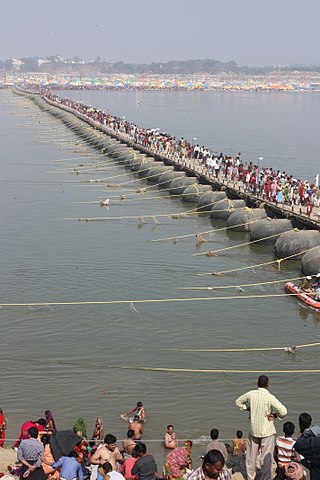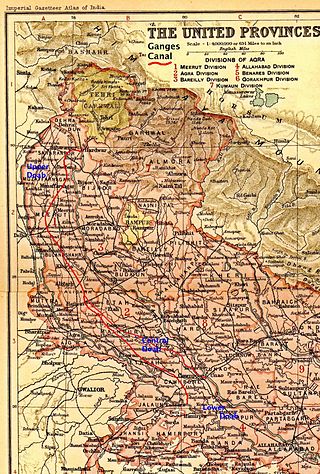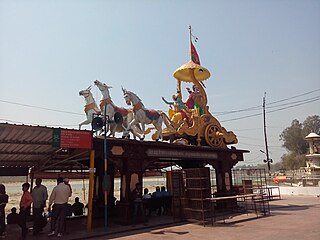
Haridwar is a city and municipal corporation in the Haridwar district of Uttarakhand, India. With a population of 228,832 in 2011, it is the second-largest city in the state and the largest in the district.

Kumbh Mela or Kumbha Mela is a major pilgrimage and festival in Hinduism. It is celebrated in a cycle of approximately 12 years, to celebrate every revolution Brihaspati (Jupiter) completes, at four river-bank pilgrimage sites: Allahabad, Haridwar (Ganges), Nashik (Godavari), and Ujjain (Shipra). The festival is marked by a ritual dip in the waters, but it is also a celebration of community commerce with numerous fairs, education, religious discourses by saints, mass gatherings of monks, and entertainment. The seekers believe that bathing in these rivers is a means to prāyaścitta for past mistakes, and that it cleanses them of their sins.

The Ganges Canal or Ganga Canal is a canal system that irrigates the Doab region between the Ganges River and the Yamuna River in India.

Haridwar district also spelled as Hardwar is a district in Garhwal which is a part of Uttarakhand, India. It is headquartered at Haridwar which is also its largest city. The district is ringed by the districts Dehradun in the north and east, Pauri Garhwal in the east and the Uttar Pradesh districts of Muzaffarnagar and Bijnor in the south and Saharanpur in the west.

Rishikesh, also spelt as Hrishikesh, is a city near Dehradun in Dehradun district of the Indian state Uttarakhand. It is situated on the right bank of the Ganges River and is a pilgrimage town for Hindus, with ancient sages and saints meditating here in search of higher knowledge. There are numerous temples and ashrams built along the banks of the river.
Kankhal is a small colony in Haridwar in the Haridwar district of Uttarakhand state in India.

In Hinduism, the yatra (pilgrimage) to the tirthas has special significance for earning the punya needed to attain the moksha (salvation) by performing the darśana, the parikrama (circumambulation), the yajna, the Dhyana, the puja (worship), the prarthana, the dakshina, the seva, the bhandara, etc. These sacred places are usually located on the banks of sacred waters, such as sacred rivers or their tributaries, the kundas, the ghats, or the stepwells, or the temple tanks.

Yātrā, in Indian-origin religions, Hinduism, Buddhism, Jainism and Sikhism, generally means a pilgrimage to holy places such as confluences of sacred rivers, sacred mountains, places associated with Hindu epics such as the Mahabharata and Ramayana, and other sacred pilgrimage sites. Visiting a sacred place is believed by the pilgrim to purify the self and bring one closer to the divine. The journey itself is as important as the destination, and the hardships of travel serve as an act of devotion in themselves.
Daraganj is a prominent suburb and a landmark in the city of Prayagraj. It is the oldest suburb of Prayag at the bank of celestial river Ganges and not far from Triveni Sangam - the confluence of three sacred rivers: the Ganges and Yamuna, and the third invisible river Saraswati. Thus, Daraganj is essentially a theoretical and philosophical reference point of city now called Prayagraj.

The Sapta Puri are the seven holy pilgrimage centres in India. These are the seven holy pilgrimage sites in Hinduism, which bless the pilgrims with moksha.

Maya Devi Temple, Haridwar is a Hindu temple dedicated to goddess Maya in the holy city of Haridwar of Uttarakhand state in India. It is believed that the heart and navel of goddess Sati fell in the region where the temple stands today and thus it is sometimes referred to as a Shakti Peetha.

Chandi Devi Temple, Haridwar is a Hindu temple dedicated to Goddess Chandi Devi in the holy city of Haridwar in the Uttarakhand state of India. The temple is situated atop the Neel Parvat on the Eastern summit of the Sivalik Hills, the southernmost mountain chain of the Himalayas. Chandi Devi Temple was built in 1929 by Suchat Singh in his reign as the King of Kashmir. However, the main murti of Chandi Devi at the temple is said to have been installed in the 8th century by Adi Shankaracharya, one of the greatest priests of Hindu religion. The temple also known as Neel Parvat Teerth is one of the Panch Tirth located within Haridwar.
Uttarakhand is a state in the northern part of India. It is often referred to as the "Devbhumi" due to its religious significance and numerous Hindu temples and pilgrimage sites found throughout the state. As a result, religious tourism forms a major portion of the tourism in the state. Uttarakhand is known for the natural environment of the Himalayas. 2019 Tourist Arrivals Domestic – 40,000,000 per/year and Foreigner – 150,000 per year. Tourism business in Uttarakhand generated ₹ 23,000 crores during 2013–14.

The Dev Deepavali is the festival of Kartik Poornima celebrated in Varanasi, Uttar Pradesh, and Jharkhand India. It falls on the full moon of the Hindu month of Kartika and takes place fifteen days after Diwali. The steps of all the ghats on the riverfront of the Ganges River, from Ravidas Ghat at the southern end to Rajghat, are lit with more than a million earthen lamps (diyas) in honour of Ganga, the Ganges, and its presiding goddess. Mythologically, the gods are believed to descend to Earth to bathe in the Ganges on this day. The festival is also observed as Tripura Purnima Snan. The tradition of lighting the lamps on the Dev Deepawali festival day was first started at the Dashashwamedh Ghat by Pandit Kishori Raman Dubey in 1991.

Triveni Ghat is a ghat situated in Rishikesh, Uttarakhand. It is the biggest and most famous ghat in Rishikesh at the banks of Ganges. Triveni Ghat remains overcrowded with devotee to take ritual baths to get cleansed from their sins. It is believed that the ghat was visited by Lord Krishna when he got hurt by the arrow of Jara – a hunter. Being the most venerated ghat in Rishikesh, Triveni Ghat is even used by devotees to perform the last rites and rituals of their loved ones. The ghat is famed for the Ganga aarti performed to the chants of Vedic hymns. The sight of oil leaves, filled with diya and petals, which are released by devotees, floating on the pristine Ganga and the traditional aarti is a sight to behold. On the bank of Triveni Ghat, one can visit the Gita Mandir and Lakshminarayan Temple. Dawn boat ride along the Ganges is a must on a short tour to Triveni Ghat.

The Kumbh Mela at Haridwar is a mela held every 12 years at Haridwar, India. The exact date is determined according to Hindu astrology: the Mela is held when Jupiter is in Aquarius and the Sun enters Aries.

Tirath Singh Rawat is an Indian politician, a sitting Member of Parliament and former Chief Minister of Uttarakhand. He was elected to the 17th Lok Sabha from the Garhwal constituency in the 2019 Indian general election as member of the Bharatiya Janata Party. He was the party chief of Bharatiya Janata Party Uttarakhand from 9 February 2013 to 31 December 2015 and former member of Uttarakhand Legislative Assembly from Chaubattakhal constituency from 2012 to 2017. He was also the first Education Minister of Uttarakhand.

Ganga Dussehra, also known as Gangavataran, is a Hindu festival celebrating the avatarana (descent) of the Ganges. It is believed by Hindus that the holy river Ganges descended from heaven to earth on this day. Ganga Dussehra takes place on Dashami of the waxing moon of the Hindu calendar month Jyeshtha. The festival celebration lasts ten days, including the nine days preceding this holy day.
The Gurdwara Gyan Godri Sahib, also known as Gurdwara Sri Gyan Godri Sahib, meaning "treasure of knowledge" was one of the holiest Gurdwara at Har Ki Pauri, Haridwar in the state of Uttarakhand, India. It existed at the place where The Bharat Scouts and Guides office exists today at the market in Subhash Ghat of Har Ki Pauri which is verified by Municipal Corporation Haridwar records of 1935.

The Clock Tower of Haridwar, also known as the Raja Birla Tower, is a landmark structure on Malviya Island, opposite the steps of Har Ki Pauri, Haridwar, Uttarakhand, India.



















